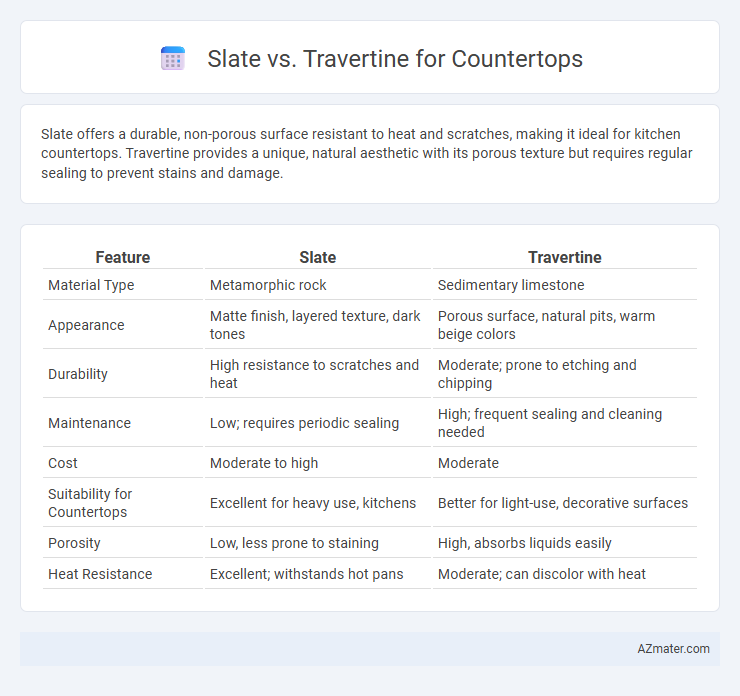Slate offers a durable, non-porous surface resistant to heat and scratches, making it ideal for kitchen countertops. Travertine provides a unique, natural aesthetic with its porous texture but requires regular sealing to prevent stains and damage.
Table of Comparison
| Feature | Slate | Travertine |
|---|---|---|
| Material Type | Metamorphic rock | Sedimentary limestone |
| Appearance | Matte finish, layered texture, dark tones | Porous surface, natural pits, warm beige colors |
| Durability | High resistance to scratches and heat | Moderate; prone to etching and chipping |
| Maintenance | Low; requires periodic sealing | High; frequent sealing and cleaning needed |
| Cost | Moderate to high | Moderate |
| Suitability for Countertops | Excellent for heavy use, kitchens | Better for light-use, decorative surfaces |
| Porosity | Low, less prone to staining | High, absorbs liquids easily |
| Heat Resistance | Excellent; withstands hot pans | Moderate; can discolor with heat |
Introduction to Slate and Travertine Countertops
Slate countertops offer durability and a sleek, matte finish, making them resistant to heat, scratches, and stains, ideal for modern kitchen designs. Travertine countertops provide a natural, porous texture with unique veining and warm earthy tones, enhancing rustic or Mediterranean-style interiors. Both materials require proper sealing to maintain their beauty and resist moisture absorption in high-use kitchen environments.
Material Composition and Origin
Slate, a metamorphic rock primarily composed of fine-grained clay minerals and quartz, originates from regions like the northeastern United States and Wales, offering dense, durable properties ideal for countertops. Travertine, a form of limestone deposited by mineral springs, especially abundant in areas such as Italy and Turkey, features a porous texture with natural pits and troughs that provide a unique aesthetic but require sealing for countertop use. Both materials differ significantly in composition and origin, impacting their durability, maintenance, and appearance in kitchen environments.
Appearance and Aesthetic Appeal
Slate countertops offer a sleek, uniform appearance with deep, rich shades ranging from charcoal to dark green, providing a modern and sophisticated look. Travertine showcases a natural, earthy aesthetic with warm tones like beige, cream, and rust, characterized by its distinctive porous texture and veining. Both materials enhance kitchen and bathroom decor, but slate lends a contemporary vibe while travertine adds timeless, rustic charm.
Durability and Longevity
Slate countertops offer exceptional durability due to their dense, non-porous structure, making them resistant to scratches, heat, and stains, which contributes to a long lifespan with minimal maintenance. Travertine, while aesthetically appealing with its natural veining, is more porous and softer, requiring regular sealing to prevent damage from spills and scratches, which can affect its longevity. Overall, slate provides superior resilience and extended durability compared to travertine, making it a more practical choice for high-traffic kitchen environments.
Maintenance Requirements
Slate countertops require minimal maintenance, needing only occasional sealing every few years to prevent staining and maintain durability. Travertine countertops demand more frequent sealing due to their porous nature, which makes them susceptible to staining and etching from acidic substances. Regular cleaning with pH-neutral cleaners and prompt spill management is essential to preserve the surface integrity of travertine countertops.
Resistance to Heat and Stains
Slate countertops exhibit excellent resistance to heat, tolerating temperatures up to 1,200degF without damage, making them ideal for kitchen use near hot cookware. Travertine, while heat resistant to moderate temperatures, is more porous and susceptible to staining from acidic substances and oils, requiring sealing and careful maintenance. Slate's dense, non-porous surface also provides superior stain resistance compared to the more porous travertine, making slate a more durable choice for heavy-use countertops.
Cost Comparison
Slate countertops generally cost between $50 to $100 per square foot, making them a mid-range option known for durability and unique texture. Travertine countertops typically range from $45 to $75 per square foot, slightly more affordable but require more maintenance due to their porous nature. Installation costs for both materials vary with complexity, though travertine often incurs additional sealing expenses to prevent staining.
Installation Process and Considerations
Slate countertops require precise cutting and sealing to prevent moisture absorption, with installation typically involving professional tools for cutting and edge finishing due to its dense, fine-grained composition. Travertine, characterized by its porous texture, demands thorough sealing both before and after installation to avoid staining; its softer nature allows for easier cutting but requires careful handling to prevent chipping. Both materials benefit from level substrate preparation and careful adhesive application to ensure long-lasting durability and aesthetic appeal in kitchen installations.
Environmental Impact and Sustainability
Slate countertops offer a more sustainable choice due to their natural abundance, minimal quarrying impact, and long-lasting durability, often requiring less energy-intensive processing than travertine. Travertine, a form of limestone, involves more extensive extraction and processing, contributing to higher carbon emissions and environmental disturbance. Choosing slate reduces ecological footprint by promoting less resource-intensive manufacture and supporting longevity in kitchen design.
Pros and Cons Summary
Slate countertops offer superior durability and resistance to scratches and heat, making them ideal for heavy kitchen use, but their limited color options and higher cost may be drawbacks. Travertine countertops provide a unique, natural aesthetic with warm tones and elegant veining, yet they require regular sealing due to porosity and are more prone to staining and etching. Both materials demand specific maintenance routines, but slate generally offers a lower upkeep burden than travertine in countertop applications.

Infographic: Slate vs Travertine for Countertop
 azmater.com
azmater.com